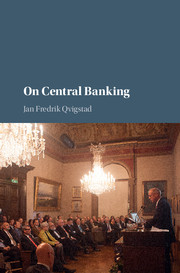Book contents
Foreword page
Published online by Cambridge University Press: 05 July 2016
Summary
I first met Jan F. Qvigstad in the spring of 2007 when he and Øyvind Eitrheim came to see me at King's College, Cambridge, when I was on sabbatical, to discuss the plans for the Norges Bank's bicentenary celebration. Jan is a very impressive central bank deputy governor who is not only a very able technical monetary economist but also a polymath – he is a scholar of the arts, the sciences, and the humanities.
Jan has spent much of his career at Norges Bank with some excursions to the academic world. He worked his way up the ladder to become Deputy Governor and Vice-Chairman of the Executive Board of the Norwegian Sovereign Wealth Fund. As an economist he has written a number of important policy papers, including one in 2006, “When Does an Interest Rate Path ‘Look Good’? Criteria for an Appropriate Future Interest Rate Path” which has led to what Carl Walsh, a leading scholar of central banking, has recently dubbed
the Qvigstad Rule, a useful rule of thumb for inflation targeting central banks to assess monetary policy…. It has the advantage of focusing on things we care about – inflation and real activity – rather than the setting of the policy instrument…. If inflation is above target the output gap should be negative and vice versa. If inflation is above target and the output gap is also positive, then policy is too loose; if inflation is below target and the output gap is negative, policy is too tight.
(Walsh 2014)Most important and most interesting are the six annual lectures Jan gave at the Norwegian Academy of Science and Letters from 2008 to 2013. The lectures are lessons or homilies for how to be a good central banker. All the lectures are grounded in the history of Norges Bank and the history of central banking in general. The six lectures are intertwined and then summarized in his most recent lecture, “On Institutions.”
Lecture 1: On Keeping Promises
To establish credibility central banks have to keep their promises. Promises are hard to keep because future temptations come along to break them.
- Type
- Chapter
- Information
- On Central Banking , pp. xi - xxviiiPublisher: Cambridge University PressPrint publication year: 2016
- 3
- Cited by

